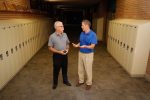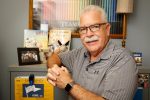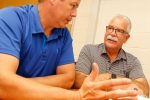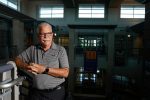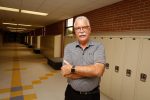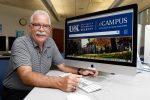 By TODD GOTTULA
By TODD GOTTULA
UNK Communications
Deshler, Nebraska.
It is where Dick Meyer grew up. In a house on Hebron Avenue, across from St. Peter Lutheran school.
It is the town where he developed a love for math and science, and respect for his teachers – who put an emphasis on personal relationships and teamwork.
“I had great relationships with my teachers,” said Meyer. “I emulated them, and I grew up wanting to be like them.”
Deshler is tucked away south of Highway 136 in southeast Nebraska, just west of Hebron.
It is where Meyer’s dad, Clarence, worked for the local dairy, picking up milk, eggs and cream from farmers and delivering to area stores. Where his mom, Lucille, worked as a secretary for Holle Insurance Agency.
And it is where church and education lined up side by side in his youth.
“I grew up thinking everybody was Lutheran,” joked Meyer, noting his hometown had four Lutheran elementary schools.
“I always loved school. My mom worked, so after school we went to the neighbor’s house and played school. I just always liked being in school. I liked the environment. I liked learning.”
Meyer, associate professor and chair of educational administration at UNK, gained an early interest in education, which has led to a 42-year career as a teacher and administrator.
“I still remember all those lessons growing up, in and out of the classroom,” he said. “I grew up in a terrific environment in Deshler, and that has always stuck with me.”
TRANSITION TO HIGHER ED
Meyer’s career path includes 27 years as a middle school and high school principal at schools in Holdrege, Columbus, Humphrey and Wolbach.
 Much of his research focuses on curriculum assessment, school improvement processes and using data to improve student learning. His research also examines formative assessment leadership and professional development for teachers.
Much of his research focuses on curriculum assessment, school improvement processes and using data to improve student learning. His research also examines formative assessment leadership and professional development for teachers.
As a UNK faculty, Meyer teaches educational administration courses such as: Social Foundation of Education, Assessment Leadership, Supervision of Instruction, Technology Tools for Teachers and Intro to Educational Research.
“I could always relate to students, and I think that remains a strength of mine today. One of the things I always tried to do as a principal was be visible and out among the kids. I would stand in the hallways, shake kids’ hands and greet them each morning.”
Meyer was 26 years old when he got his first job as principal, at Wolbach Public Schools. He also served as athletic director, coached football and taught geometry there.
“I knew being young that I’d have to work at being a leader because in most cases my faculty members were older than me. Building relationships and earning respect was a real challenge early in my career, but I always liked that interaction with students, teachers and other administrators.”
Following 38 years working in public schools, Meyer decided to enter the world of higher education. He had worked at UNK as an adjunct, and he said it was a natural move to join UNK fulltime in 2013. He worked the previous seven years as curriculum, instruction and assessment director with Kearney Public Schools.
“I always thought I would enjoy working with graduate students and help educate principals,” he said. “I saw teaching at UNK as an extension of what I was doing at KPS.
“It was a little scary not knowing how everything operates in higher ed, but I knew I could learn it. I had the administrative skills and that strong base in education needed to be successful in this environment.”
Meyer said his past relationships with administrators benefit his research and work in UNK classrooms.
“Relationships are extremely important. I talk a lot with our faculty and students about being connected to K-12, visible and talking frequently with school leaders. Staying involved and having those relationships with principals and superintendents is so important in terms of recruiting students to our programs.
“I still have those relationships and bring those connections to everything I do.”
BULLYING, ANTI-SOCIAL BEHAVIORS
Bullying. It affects the social, emotional and academic success of students.
In extreme cases, it leads to suicide and is a contributing factor in young peoples’ decisions to end their own lives.
Meyer’s research on anti-social behaviors, their connection to bullying and impact on students confirms that anti-bullying programs are needed in schools to address these behaviors.
His 2016 article “Perceived Connections Between Anti-Social Gateway Behaviors and School Bullying and Culture” found that bullying is prevalent in schools and leads to mental health conditions such as depression and anxiety among young people.
 Meyer examined and compared opinions of 8th- and 9th-grade teachers and students at a suburban middle school and high school in the Midwest. He found that four out of five students and teachers involved in his study believe that anti-social behaviors occur in their classrooms.
Meyer examined and compared opinions of 8th- and 9th-grade teachers and students at a suburban middle school and high school in the Midwest. He found that four out of five students and teachers involved in his study believe that anti-social behaviors occur in their classrooms.
His research shows that 82 percent of students – and 100 percent of teachers – witnessed or were involved in bullying or anti-social behaviors. Seventy-six percent of students and 90 percent of teachers believed that a school-wide program would lessen extreme forms of bullying and improve the overall culture and school climate.
“Students are asking for our help,” said Meyer. “It’s our responsibility, as professionals, to put into place programs and systems that deal with the negative impact of bullying and also are educational and preventative.
“It’s time we start having more discussions about bullying, what it looks like and what we can do to help kids in our schools.”
Bullying remains hard to define, which often makes it even harder to address, said Meyer, whose research shows that bullying today is often psychological and does not involve physical contact.
“Whether you call it bullying or not, we all know what is acceptable behavior and what is not,” he said.
Outward physical bullying – or what Meyer’s research called “typical bullying behaviors of playgrounds of the past” – is less prevalent than harassment that occurs through social media and other settings.
These anti-social behaviors are termed “gateway” behaviors and include actions such as eye-rolling, whispering about someone and talking behind their back, or ceasing to talk when he/she is around, giggling, pointing or isolation. They are seen every day in classrooms and hallways, said Meyer.
They have been an almost accepted part of adolescent behavior through media presentation, reality television, and our own permissive response to such behaviors.
“While not as overt as some signs of bullying, these behaviors impact the culture of a school and can have negative impacts on the emotional health of a child, his/her ability to learn, and can lead to more distressing behaviors later,” Meyer said.
Anti-social behaviors often are linked to either suicide ideation or attempts in young people, Meyer said.
“This is something that we must turn our attention to in a purposeful and deliberate way. Our schools and classrooms must remain under our watchful eye.
“It is imperative that we address this. Sometimes it’s easier to pretend it doesn’t exist, ignore it and say ‘We don’t have that here in our school.’ When you look at our research, not every teacher sees this as an issue,” added Meyer. “That’s proof that we have room for improvement. The reality is this is an issue in every school.”
The Nebraska Department of Education has purchased online suicide prevention training for all Nebraska schools. That’s a positive start, Meyer said, but administrators and school personnel need some guidance in how to handle the emotional and relational health of students in their buildings.
Meyer hopes his study points educators in a new direction with regard to how to address the issue of bullying in schools and attitudes in their buildings.
Teacher intervention is crucial in addressing and reducing bullying behaviors, Meyer said, but some educators are unconvinced of the need for a formal program to address bullying. Meyer said some of the resistance stems from teachers’ lack of confidence in addressing bullying.
“We are seeing some strong efforts, but I hope schools have discussions on top of that. We need to make sure we’re paying attention and not just reacting when something terrible happens, when something extreme occurs. If our teachers, principals, superintendents ignore things, it is just going to build.”
ONLINE LEARNING MODELS
Online learning is expanding rapidly. In fact, online enrollment at many universities is growing faster than traditional enrollment.
Meyer’s 2016 article “Models of Administration for Online Learning Programs in the U.S Higher Education Institutions” examined two online learning models in 85 higher ed institutions and universities across the United States.
 Working with staff and administrators of distance learning programs, his research focused on Centralized Administration and Decentralized Administration models. The centralized model has one office or department in charge of everything related to online learning. The decentralized model has many online learning departments or offices within its colleges, and is more common at large universities.
Working with staff and administrators of distance learning programs, his research focused on Centralized Administration and Decentralized Administration models. The centralized model has one office or department in charge of everything related to online learning. The decentralized model has many online learning departments or offices within its colleges, and is more common at large universities.
Meyer’s research indicates online learning programs under the Centralized model are more common, and stronger.
“The centralized model is a more streamlined approach, which expedites decision making and implementation of programs. People in institutions using a centralized model tended to be more satisfied with their online learning program than those using the decentralized model,” the research said.
The centralized model provides more consistency.
“Under this model, college administrators and leaders who have knowledge of programs offered and needs of their online students provide input to the decision makers,” Meyer said.
“It is more consistent when one office oversees things as opposed to a bunch of people just doing their own thing.
If you get too many pockets all disseminated out, a program becomes strong on one side and weak on the other.”
Meyer’s research also showed that staff and administrators involved in online learning programs were most concerned about high-level administrative support, specifically in areas of funding, guidance and oversight. Administrative leadership significantly affects the quality of an online learning program, said Meyer.
“Colleges and universities need to plan and devote appropriate resources in order to develop quality online programs where students are able to demonstrate success,” he said. “This will not happen without administrators who provide leadership and vision for the institutional direction regarding the role of online learning at the institutional level.”
Course design, technology, faculty development and faculty competence all affect success of distance education, Meyer said.
Developing and articulating an institutional strategy is key to that success, he stressed.
“You have to be clear on your mission, vision and what you want to accomplish. And then you have to communicate it to everyone,” Meyer explained. “You can’t just hope it happens. You can’t just tell your faculty the vision. You have to have continual discussion and have involvement. The message has to be consistent and shared over and over.”
RESEARCH NOT EASY
Research is a challenge, said Meyer, and he is matter-of-fact when asked about the difficulty in getting published.
“Publication of research is not a priority in K-12, so research is very difficult for me because I spent so many years in that environment,” he explained. “The shift to publishing manuscripts has been a steep learning curve.
“When I was in K-12, I collected data but didn’t really publish. The academic writing piece didn’t occur. Research has been a new challenge. It has forced me to get off autopilot and out of my comfort zone.”
The biggest thing he learned about research is being clear on what his question is going in.
“That’s not as easy as it sounds, but having clarity and defining what it is you’re after is key,” Meyer said. “Once you have that question, figuring out what you need to find the answers is easier.
 “I’m very detailed and organized, so I need to know how everything relates to each other and supports each other. For me, that all needs to line up.”
“I’m very detailed and organized, so I need to know how everything relates to each other and supports each other. For me, that all needs to line up.”
Meyer said working with UNK faculty Phu Vu, Martonia Gaskill and Matthew Bice has shaped his research knowledge.
“Finding others to mentor and collaborate with has been extremely important and helpful in my ability to get manuscripts published. I developed a connection right away with them. I know I can always go to them and ask for help with a piece of writing.”
Seeing his work get published remains exciting for Meyer.
“I really like messing with numbers, running the stats and analyzing it all because I’m a quantitative guy. That is what I really enjoy about research. I also really enjoy getting published. That’s still a thrill for me, and I think it always will be.”
When asked what he wants people to take away from his research, Meyer steps away from the details.
Ultimately, the success of former students and people he’s worked with is what drives him.
“I want to improve education by helping people achieve their goals, particularly on the administrative side. I like helping students get where they want to go in their lives and careers. I get frustrated when people in higher education lose sight of that.
“I try to have conversations and create relationships with students that help them become successful. People, student success and relationships has always been my driving force.”
DICK MEYER
Title: Associate Professor and Chair, Educational Administration
College: Education
Education: Education Doctorate, University of Nebraska-Lincoln, 2008; Master of Education, University of Nebraska-Lincoln, 1978; Bachelor of Science, University of Nebraska-Lincoln, 1975.
Years at UNK: 4
Career: Curriculum, Instruction and Assessment Director, Kearney Public Schools, 2006-13. Middle School and High School Principal, Holdrege Public Schools, 1995-2006. Middle School Principal, Columbus Public Schools, 1991-95. Middle School Principal, Holdrege Public Schools, 1984-91. K-12 Principal, Humphrey Public Schools, 1981-84. Grades 7-12 Principal, Wolbach Public Schools, 1979-81. Math Teacher, Culler Junior High, Lincoln Public Schools, 1975-79.
Family: Wife, Sheila; Sons: Aaron, 33; Lane, 31; Cole, 31; and Quentin, deceased. Grandchildren: Jaxon, Leo, Ellis and Nixon.
Hobbies/Interests: Watching college sports, watching professional baseball, traveling, golf, visiting wineries and breweries.
Honors/Awards: Al Kilgore Award of Excellence, Nebraska Association of Supervision and Curriculum Development, 2014. Nebraska High School Principal of the Year, Nebraska Council of School Administrators, 2002. Region IV High School Principal of the Year, Nebraska Council of School Administrators, 2000. Region IV Distinguished Elementary Principal of the Year, Nebraska Council of School Administrators, 1998.
Areas of research/specialization: Continuous school improvement, Using data to improve learning, Formative assessment, Professional development, Improvement of instruction.
Courses taught: Educational Administration courses: Social Foundation of Education, Assessment Leadership, Supervision of Instruction, Technology Tools for Teachers, Intro to Educational Research, Endorsement Internship, Independent Reading, Field Study, Internship.
Recent Published Articles:
- “Improving Teaching and Learning Using the Keeping Learning on Track Professional Development Program and Strategies,” Journal for Leadership and Instruction, 2017.
- “Perceived Connections between Anti-Social Gateway Behaviors and School Bullying and Culture,” Higher Education Studies, 2016.
- “Models of Administration for Online Learning Programs in the U.S Higher Education Institutions,” Journal of Applied Educational and Policy Research, 2016.
- “Help at 3 AM! Providing 24/7 Timely Support to Online Students via a Virtual Assistant,” Online Journal of Distance Learning Administration, 2016.
- “Rating User Interface and Universal Design in MOOC Course Design,” International Journal of Technologies in Higher Education, 2015.

